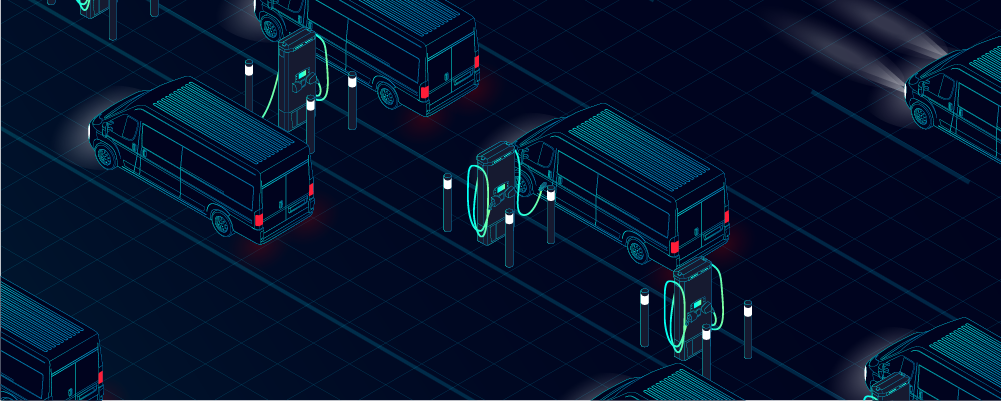Five Steps to Fast Charging for Your Fleet

Fleets across the world are going electric, but many fleet owners are still asking: How do I implement fast charging to move more goods and people? Here are five steps to get started with fast charging for your EV fleet.
1. Find Funding
There are many incentives available for businesses who want to install fast chargers for their fleets. In Europe, the European Green Deal provides funding for EV charging stations. For example, Germany approved €1.8 million in funding to build a network of public charging stations that will encourage German citizens to switch to EVs. There are many funding programs available throughout Europe available for EVs and EV charging infrastructure, many of which are outlined on the European Automobile Manufacturers Association website. The European Commission has also compiled a list of incentives for EVs and EV chargers.
In the United States, the Inflation Reduction Act provided nearly $370 billion in climate change investments that included incentives for EV charging infrastructure. The Alternative Fuel Vehicle Refueling Property Credit covers 30% of total costs of purchase and installation of charging equipment—up to $100,000 per charger.
2. Choose a Charger
Fast chargers can help your fleet move more goods or passengers so your fleet vehicles can spend less time charging and more time on the road. But there are many types of fast chargers and fast charging configurations. When choosing a fast charger, consider:
Charging Time Requirements
Your fleet may consist of vehicles with high-capacity batteries that would benefit from ultra-fast chargers. Or you may operate a fleet of passenger vehicles that don’t require ultra-fast charging. Before you choose a charger, consider how your vehicles will be used, how long they can be off the road for charging, and how quickly they can charge. For example, large electric cargo trucks with high-capacity batteries could benefit from shortened charge time offered by 150kW-plus chargers, whereas lower-capacity electric city taxis could use 75kW chargers.
Available Space
How much space is available for your chargers? Do you need compact, all-in-one chargers like our Tritium RTM75, or do you have space and the need for a complete charging system like our Tritium PKM150? Your charging site location can determine which chargers are right for you.
Upgradability
EV development moves quickly and while your current fleet vehicles may only be able to effectively charge at 50kW, your future vehicles may be able to charge at much faster rates: 150kW and above. Look for modular chargers like our RTM75 and PKM150, which can be upgraded over time to meet faster charging requirements.
Durability
Fleet vehicles have rough service lives, and their chargers may also be exposed to harsh conditions. Look for chargers that are built to last and to endure no matter where they’re installed. Our RTM75 and PKM150 chargers are fully sealed with an IP65 rating, so they can operate in a wide temperature range and keep dust and dirt away from sensitive electronic components.
Scalability
Individual chargers can be upgraded over time, but charger system can also be scaled to meet charging demands. For example, the Tritium PKM150 power grid system can be easily scaled from two to four chargers without additional equipment. The PKM150 power rectifier (power cabinet) can accommodate up to four chargers. The system automatically balances the power requirements of charging vehicles, ensuring each vehicle gets the power it needs when it needs it.
3. Plug Into the Grid
Direct current (DC) fast chargers require a high-voltage, high-capacity power source. Many commercial and industrial areas are equipped to handle fast charger installations, but some retail areas or locations in older cities and towns may require new power feeds or even electrical substations. Consult your local utility or council to determine if your proposed charging location has the power you need to support your chargers. Tritium experts can help you find the correct local authority or electrical contractor to determine whether your charging site will need additional utility work.
4. Find an Installer
DC fast chargers must be installed by qualified companies to ensure safe operation. Work with your charger manufacturer to find a certified installer in your area. Most installers can help with wiring, site preparation, excavation, and anything else required to get your chargers up and running. Tritium works with qualified, certified installers across the globe to ensure our chargers are properly installed and can operate for years without replacement.
5. Find a Maintenance Provider
DC fast chargers move an incredible amount of energy—potentially millions of kilowatt hours over the course of their lifespans. Over time the internal components of a DC fast charger can degrade, just like any other piece of machinery that sees heavy use. External components like screens, buttons, and charging cables can also get damaged during normal use, or in an accident. To ensure your chargers remain operational and available, find a maintenance provider that can diagnose and repair chargers in the field. Tritium works with maintenance providers across the globe to ensure chargers are operational and available when they’re needed most. Work with your charger manufacturer to find a maintenance provider that can help keep your chargers up and running. Look for a maintenance provider who:
- Is trained to maintain your specific charger
- Has access to parts for repairs
- Can agree to service and repair timeframes
- Has a response time that meets your operational needs
Once your chargers are installed and a maintenance contract has been secured, you’re ready to get charging!
Contact one of our experts to get started and learn more about how to implement fast-charging solutions for your fleet.